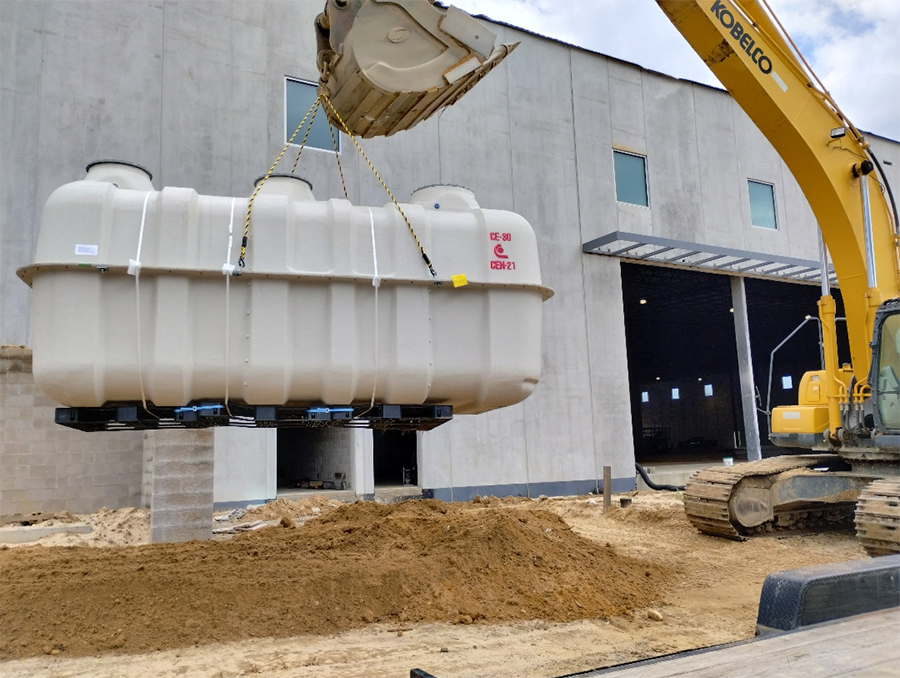Commercial Design Considerations
The FujiClean System – Like all other I/A OWTS technologies approved for use on Long Island -- is designed to treat residential strength wastewater and is essentially "plug and play" for residential applications. However, commercial strength wastewater is typically much more concentrated, as the strength of the wastewater generated by most commercial uses does not get diluted by showers/baths, laundry, kitchen sinks, etc. Commercial uses also vary widely from project to project – a there are certain design considerations that must be considered in the commercial context.
FujiClean CEN systems are approved for the following residential design flows, or “hydraulic loads,” rated in gallons per day (gpd):

While all of these FujiClean units are also approved for commercial use, proper commercial design entails more than simply calculating the hydraulic load for the project and specifying an I/A System that meets those minimum standards. It requires taking the time to understand the business and its needs. Is it a restaurant? A public restroom? An office with four employees? Each of these businesses have vastly different needs and require different approaches. There are a number of additional components that may be necessary for a commercial system to perform properly that you would rarely if ever need on a residential project, such as:
- Primary Treatment (aka Trash Tank) – For most commercial projects, Fuji Clean recommends the use of a Primary Treatment tank to capture large solids and inorganic materials (diapers, wipes, hygiene products, etc) that have a much higher tendency to get flushed down the drain at a commercial site than they do at a residential site. The primary treatment tank also serves the purpose of reducing BOD (Biochemical Oxygen Demand) by up to 30 percent.
- Pre-Aeration - For some projects, it might be necessary to add a pre-aeration component by pumping air into the Primary Treatment tank so that the BOD can be further broken down before entering the Fuji Clean system.
- Flow Equalization - Treatment is most effective when the wastewater flow matches capacity. While trash tanks and pre-aeration are used to moderate solids and organics loading, flow equalization is used to moderate flow where commercial operational hours are particularly variable. Think about a church that generates nearly all of its wastewater volume one day per week over a 4-hour period. The goal of flow equalization is to retain the peak flow and spread the dosing into the FujiClean consistently over a 24-hour period, so that the untreated wastewater doesn’t overload and pass through the treatment system into the drainage field without being processed.
- Carbon Supplement – I/A systems require the proper ratio of carbon to properly treat wastewater. This is not an issue in residential scenarios, as sufficient carbon is provided by the solid waste that consistently enters the system. However, some commercial uses have a tendency to introduce an abundance of urine but a minimal amount of solid waste to the system, which starves it of carbon. In such scenarios, FujiClean may recommend incorporating a carbon feed in the commercial design to provide the proper ratio of carbon and allow the system to properly treat the commercial waste stream.
- HS-20 Traffic Bearing Components –FujiClean treatment systems are constructed of fiberglass reinforced plastic (FRP), and therefore cannot be installed directly in a parking lot or driveway without additional structural support to protect them from the vertical and lateral forces from vehicles driving over the tanks. AWS has secured approvals from the Suffolk County Department of Health Services for traffic bearing options for each of its treatment units. Additional information, including the SCDHS approval letters, detail drawings and dwg files for these traffic-bearing options can be found on the “Resources” page of this website. Please note that all traffic-rated installations should also incorporate oversized cast iron covers to allow for the use of gasketed Tuf-Tite lids underneath that provide a gasketed seal that cannot be accomplished with the cast iron.
- Additional Treatment Capacity – Because the effluent from commercial uses is often more concentrated than residential effluent, it may be necessary to provide additional treatment capacity in order to meet the SCDHS requirement of 19 mg/l of total nitrogen. For example, a commercial use with a hydraulic load of 1,000 gpd may require more than a CEN10 treatment system in order to properly treat the higher strength effluent generated by that use.

Let Fuji Clean's Commercial Team Assist With Your Next Design!
FujiClean is committed to ensuring that its commercial treatment systems are properly designed to meet or exceed the standards set by local regulators. As such, FujiClean has a dedicated commercial design consultant (Mike Dunn) is available to review and provide recommendations on every commercial FujiClean project designed for the Long Island market. The first step for any commercial project is to fill out and email a Project Design Worksheet to AWS and/or FujiClean (info@awsli.com / mike@fujicleanusa.com), and FujiClean will promptly review and respond with customized comments and recommendations for the project. Filling out this simple form with as much detail about the proposed project as possible will make for an easier and more effective commercial design process!
Request a FujiClean Commercial Design Manual Today!
FujiClean has developed a commercial design manual customized for the Long Island market. The password-protected manual provides FujiClean’s guidelines and best practices for commercial design and is available to all licensed engineers and architects on Long Island. To request a copy of the commercial design manual simply email AWS (info@awsli.com). AWS/FujiClean are also available to schedule lunch and learns or other training sessions (either virtually or in-person) to review the intricacies of commercial wastewater design and answer any specific questions you may have.

